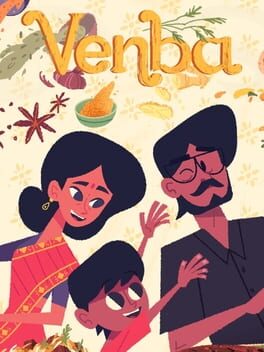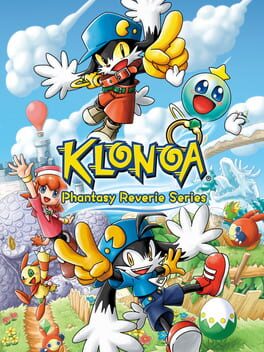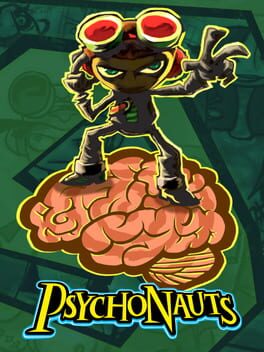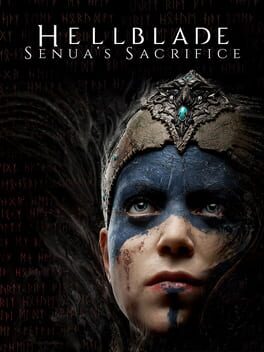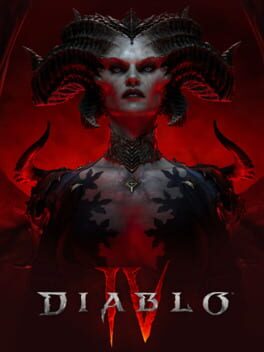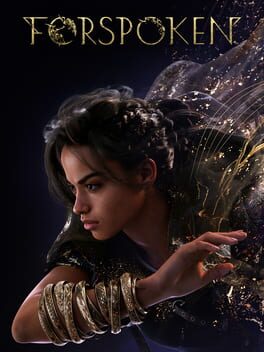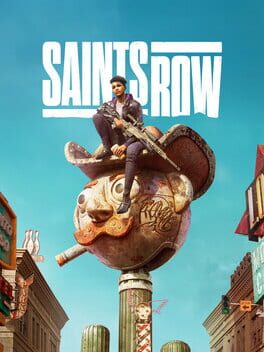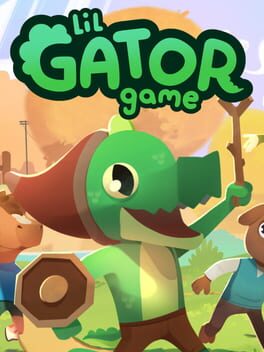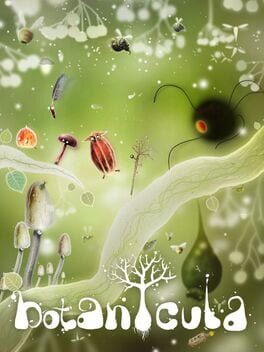TheMediaDiorama
2023
A surprisingly sad journey into ethnic dilution and cultural identity. Playing out like a visual novel, the personable story is the attraction here as we uncover the highs and lows of an Indian family who have immigrated to Canada. How a child growing up in a foreign country feels apprehensive about displaying their ethnic background, only to soon realise that they should've embraced the culture their parents bestowed upon them all those years ago. It's actually really moving.
Player interaction comes from cooking and learning about South-Indian cuisine in between the narrative time jumps. While these little puzzles are presented with such authenticity, they are perhaps too basic and limited in the mechanical department. It's basically clicking ingredients in the right order. Now I'm not expecting 'Cooking Mama' level of chopping ingredients, stirring broths etc. but to really sell this as an interactive experience it just needed more involvement. Due to how short the story is - exacerbated by the fleeting time jumps which can diminish the core emotion - it just about gets away with it.
Delectably tender in the middle, but undercooked round the edges.
Player interaction comes from cooking and learning about South-Indian cuisine in between the narrative time jumps. While these little puzzles are presented with such authenticity, they are perhaps too basic and limited in the mechanical department. It's basically clicking ingredients in the right order. Now I'm not expecting 'Cooking Mama' level of chopping ingredients, stirring broths etc. but to really sell this as an interactive experience it just needed more involvement. Due to how short the story is - exacerbated by the fleeting time jumps which can diminish the core emotion - it just about gets away with it.
Delectably tender in the middle, but undercooked round the edges.
Aside from a few graphical issues and UI changes that looked a little cheap, my affinity towards Klonoa (particularly Lunatea's Veil) remains intact. Two of the greatest games of all-time are given a lick of vibrant paint - the games themselves remain untouched (thankfully!) - and STILL retain their charm, unique level design and soundtracks that just slap. You'll be hard pushed to find 2.5D (or any other) platformers with as much imagination and fluidity as Klonoa.
Had the biggest "nostalgia bomb" playing these childhood - and current - favourites and will absolutely be playing them again, and again...and again...
Had the biggest "nostalgia bomb" playing these childhood - and current - favourites and will absolutely be playing them again, and again...and again...
2005
Some of the most frustrating, inane and clunky level design, boss fights and questionable UI designs I've ever experienced from a platformer. The collectibles were nonsense, that stupid Milkman level almost made me uninstall the game with how mind-numbingly aggravating its design was. I got through it, only to be eventually met with that stupid Waterloo board game level, and that was the final straw.
It's just aged atrociously and I legitimately preferred Balan Wonderworld. Don't @ me!
It's just aged atrociously and I legitimately preferred Balan Wonderworld. Don't @ me!
Hellblade: Senua's Sacrifice intensifies the abnormalities surrounding psychosis through a visceral journey into the hellish underworld of Norse mythology, bravely blending a neurological deficiency with a dark fantastical hack-and-slash interactive experience.
WHAT I LIKED:
+ "The hardest battles are fought in the mind". Psychosis is the mental condition resulting in difficulties when determining what is reality and what is fantasy, such as suffering with delusions and hallucinations. Senua, a Celtic warrior, strives to travel to Helheim to rescue the soul of her dead lover from the Norse goddess of death Hela. Throughout her perilous journey, she becomes afflicted with a curse which conjures otherworldly enemies for Senua to combat and haunts her mind with the voices of darkness. Upon failure, the curse overwhelms her body and rots her flesh until she is no more. Ninja Theory's writer Antoniades, along with several neuroscientists and mental health specialists, sublimely supply a metaphor throughout Senua's Sacrifice that uniquely approaches the condition without forcing Senua to be a conduit for the condition. Through the use of backstory and heightened memories, Senua instantly becomes a fleshed out character without embodying the mental condition as a gimmick. She is not defined by the condition, rather the player experiences the turmoil with her. Subconsciously internalising the world to which she perceives it. It is, without a doubt, a masterful representation of a tricky mental condition to convey through art. To conceive a compelling narrative, build a melancholic world and raise awareness on psychosis, is nothing short of genius.
+ "A life without loss is one without love". Senua, captured in full motion capture by the talented Melina Juergens, is a performance to be reckoned with. The ferocity through the psychological horror. The tenacity through her unwavering determination. The fury buried deep with her, as she unleashes her anger out upon the world. It is breathtakingly intense. From the glares into the player's soul, to the vehement screams as she crumbles to the ground. For the entirety of her quest, Senua along with player will struggle to breathe. The inclusion of live action performances, reflecting her memories, and integral voice acting narration which act as verbal indications for the player, are purposefully designed to fit around Senua's condition. And it works, effortlessly.
+ "You destroyed everything! Everyone! But not me! Fight me now!". Blending a variety of genres, the core game mechanic ultimately relies on its hack-and-slash roots. Senua is provided with limited moves, such as a light/heavy attack and blocking capabilities. However the beauty of Senua's combat, despite its limitations, is how tight the controls are. Every slash of her sword and every dodge from oncoming enemy attacks felt instantly responsive, with a satisfying weight to them. The narrative is the key focus, therefore the combat's complexities are simplified to allow Hellblade to be as accessible as it can be, along with difficulty settings for the combat encounters.
+ In blindness, there can be wisdom; only by giving, can you receive in return". Along with the intense combat sequences and scenes of horrific nature, Senua has the ability to "focus" on runes and other visual distortions that correspond to the condition of psychosis. Elements and mechanics that are not visible for anyone else. These puzzling elements involve the player to use the environment to create runes, travel between a past and present world and mend broken shards to form a new path. Whilst not challenging, these moments allowed Hellblade to slow down the pace and breathe, building upon Senua as a character and the central narrative metaphor.
+ "Turn your back on death and you only see the shadow that it casts". Ninja Theory pulled one of the greatest implications in a linear game ever: permadeath. The correlation between erasing the player's save data if Senua dies too many times and the way fear is introduced to a person. The fact that this mechanic was a bluff all along proves how fear can be a catalyst for mental illness, and for many it kept them on their toes throughout the 4-5 hour game.
WHAT I DISLIKED:
- "This is the price she pays for seeing things differently". Hellblade is a work of art. It truly, truly is. A short intense gaming experience like no other. Yet, more often that not, the inconsistent pacing threw me off course. The blending of game mechanics was not as seamless as it could've been. The first act balancing the combat with the puzzle solving intuitively, as Senua faces two illusory trials. The second act, involving memory shards, was absent of combat and solely relied on puzzle solving. Then the conclusive third act, Senua approaching Helheim, focused on endless hordes of enemies to slay without incorporating any of the new puzzle mechanics that were previously introduced. From a gameplay perspective, Hellblade is too segregated and vastly ambitious with its ideas, that it cannot perfectly merge them all together in a cohesive way. Ultimately separating the supremely artistic narrative from the occasionally cumbersome core game.
VERDICT:
9/10 rune totems
WHAT I LIKED:
+ "The hardest battles are fought in the mind". Psychosis is the mental condition resulting in difficulties when determining what is reality and what is fantasy, such as suffering with delusions and hallucinations. Senua, a Celtic warrior, strives to travel to Helheim to rescue the soul of her dead lover from the Norse goddess of death Hela. Throughout her perilous journey, she becomes afflicted with a curse which conjures otherworldly enemies for Senua to combat and haunts her mind with the voices of darkness. Upon failure, the curse overwhelms her body and rots her flesh until she is no more. Ninja Theory's writer Antoniades, along with several neuroscientists and mental health specialists, sublimely supply a metaphor throughout Senua's Sacrifice that uniquely approaches the condition without forcing Senua to be a conduit for the condition. Through the use of backstory and heightened memories, Senua instantly becomes a fleshed out character without embodying the mental condition as a gimmick. She is not defined by the condition, rather the player experiences the turmoil with her. Subconsciously internalising the world to which she perceives it. It is, without a doubt, a masterful representation of a tricky mental condition to convey through art. To conceive a compelling narrative, build a melancholic world and raise awareness on psychosis, is nothing short of genius.
+ "A life without loss is one without love". Senua, captured in full motion capture by the talented Melina Juergens, is a performance to be reckoned with. The ferocity through the psychological horror. The tenacity through her unwavering determination. The fury buried deep with her, as she unleashes her anger out upon the world. It is breathtakingly intense. From the glares into the player's soul, to the vehement screams as she crumbles to the ground. For the entirety of her quest, Senua along with player will struggle to breathe. The inclusion of live action performances, reflecting her memories, and integral voice acting narration which act as verbal indications for the player, are purposefully designed to fit around Senua's condition. And it works, effortlessly.
+ "You destroyed everything! Everyone! But not me! Fight me now!". Blending a variety of genres, the core game mechanic ultimately relies on its hack-and-slash roots. Senua is provided with limited moves, such as a light/heavy attack and blocking capabilities. However the beauty of Senua's combat, despite its limitations, is how tight the controls are. Every slash of her sword and every dodge from oncoming enemy attacks felt instantly responsive, with a satisfying weight to them. The narrative is the key focus, therefore the combat's complexities are simplified to allow Hellblade to be as accessible as it can be, along with difficulty settings for the combat encounters.
+ In blindness, there can be wisdom; only by giving, can you receive in return". Along with the intense combat sequences and scenes of horrific nature, Senua has the ability to "focus" on runes and other visual distortions that correspond to the condition of psychosis. Elements and mechanics that are not visible for anyone else. These puzzling elements involve the player to use the environment to create runes, travel between a past and present world and mend broken shards to form a new path. Whilst not challenging, these moments allowed Hellblade to slow down the pace and breathe, building upon Senua as a character and the central narrative metaphor.
+ "Turn your back on death and you only see the shadow that it casts". Ninja Theory pulled one of the greatest implications in a linear game ever: permadeath. The correlation between erasing the player's save data if Senua dies too many times and the way fear is introduced to a person. The fact that this mechanic was a bluff all along proves how fear can be a catalyst for mental illness, and for many it kept them on their toes throughout the 4-5 hour game.
WHAT I DISLIKED:
- "This is the price she pays for seeing things differently". Hellblade is a work of art. It truly, truly is. A short intense gaming experience like no other. Yet, more often that not, the inconsistent pacing threw me off course. The blending of game mechanics was not as seamless as it could've been. The first act balancing the combat with the puzzle solving intuitively, as Senua faces two illusory trials. The second act, involving memory shards, was absent of combat and solely relied on puzzle solving. Then the conclusive third act, Senua approaching Helheim, focused on endless hordes of enemies to slay without incorporating any of the new puzzle mechanics that were previously introduced. From a gameplay perspective, Hellblade is too segregated and vastly ambitious with its ideas, that it cannot perfectly merge them all together in a cohesive way. Ultimately separating the supremely artistic narrative from the occasionally cumbersome core game.
VERDICT:
9/10 rune totems
They took everything that made 'Breath of the Wild' a gaming masterpiece and made it bigger, better and staggeringly behemothic. Hyrule, sky islands, caves, wells, The Depths, five times the amount of side quests, more varied shrines, dungeons, memorable boss battles, a final boss that rivals the very best in the franchise and new abilities that makes hours upon hours of sandbox experimentation just so damn fun - just like a direct sequel should be.
If you're saying this is "$70 DLC", you clearly should apply that sentiment to near-enough every sequel ever created. Nintendo just made another masterpiece, deal with it.
If you're saying this is "$70 DLC", you clearly should apply that sentiment to near-enough every sequel ever created. Nintendo just made another masterpiece, deal with it.
2023
Raising an undead army, casting fiery infernos, slashing swords around and covering the world in blood. Yup, Diablo is back! As someone who did enjoy the linearity of Diablo III, I was slightly sceptical about the open-world aspect. But damn the amount of content thrown into this game is enormous! Five expansive regions, side quests, stat increasing statues, optional dungeons, cellars, strongholds, PVP hell fields, world bosses, events...it just keeps going and going and going. Despite the gameplay loop remaining unchanged, it's still addictive as ever (you can't deny it!). Decimating a crowd of enemies, changing armour for slight increased stats and collecting all the remaining gold is just simplistically satisfying. The campaign slapped, decently paced with gorgeous cinematics...
...but...
...post-campaign is where the issues start to show up. The level scaling becomes aggressively obnoxious - being level 50 feels no stronger than being level 2. The loot less impressive. The side quests repetitive. The mount's cooldown infuriating. The whole serotonin release from the progression just slows down to a halt.
So yeah, playing through the campaign was a blast, especially in co-op. The post-game clear-up though displays the cracks within Blizzard's hellish feast of carnage.
...but...
...post-campaign is where the issues start to show up. The level scaling becomes aggressively obnoxious - being level 50 feels no stronger than being level 2. The loot less impressive. The side quests repetitive. The mount's cooldown infuriating. The whole serotonin release from the progression just slows down to a halt.
So yeah, playing through the campaign was a blast, especially in co-op. The post-game clear-up though displays the cracks within Blizzard's hellish feast of carnage.
2019
Plays well, and cycling downhill really captures that zooming velocity. Problem is, mixing a seemingly roguelike procedurally-generated run with a sporty arcade mechanic just makes the game repetitive and boring very quickly. There's not enough variety in stunts and environments to make every run feel refreshingly fun. After an hour or so, you're pretty much done, and there's no incentive to want to come back and earn more rep points.
A detective bound to a demonic entity uncovering a family mystery in metroidvania limbos of the deceased. I mean, it's dark. The world design is Burton-esque/Lovecraftian, warped and twisted with decent exploration. Collectibles are worth seeking out and are put towards needed upgrades. The puzzles, while obtuse, had that point-and-click mystery element to it which suited the vibe. Narratively thin but...ehhh.
The BIG problem here is just how clunky Benedict controls. It almost ruins the entire game. Precision platforming is frustrating. Basic combat is frustrating. Only being able to double-jump near grapple points is frustrating. Forced stealth segment...frustrating. Chapter where your abilities are taken away from you...f r u s t r a t i n g. Even the lack of enemy variety is FRUSTRATING!
There's a good game in here, but the controls (which are hella important for a metroidvania) need a complete overhaul. No doubt this really is the LAST case of Benedict Fox.
The BIG problem here is just how clunky Benedict controls. It almost ruins the entire game. Precision platforming is frustrating. Basic combat is frustrating. Only being able to double-jump near grapple points is frustrating. Forced stealth segment...frustrating. Chapter where your abilities are taken away from you...f r u s t r a t i n g. Even the lack of enemy variety is FRUSTRATING!
There's a good game in here, but the controls (which are hella important for a metroidvania) need a complete overhaul. No doubt this really is the LAST case of Benedict Fox.
2023
"Cringey dialogue". "Unlikeable protagonist". "Woke trash". Jeez, the hatred spouting from keyboard warriors for this open-world adventure is, quite frankly, overblown to a ridiculous degree. To the point where it's now commonplace to follow the mass in their loathing without actually giving the game a chance. Could it be because the central protagonist is a strong and assertive female who speaks her mind? Knowing today's toxic environment, I wouldn't be surprised. Yes, Frey and Cuff talk to each other non-stop with limited variance in dialogue exchanges, but it's fairly easy to block out and is no where near as relentless as people would lead you to believe.
The game itself is actually very good, in my opinion. And the main reason for its greatness is Frey's fluid traversal. Gliding, sprinting, rushing and generally performing parkour to get from side of the map to the other. It's just damn fun and suits Luminous' engine (FFXV players will know...). Then an experimental element-based combat system (equipped with a temperamental lock-on system) adds more oomph to the...fray. The story itself is fairly grounded with a decent character arc for Frey, abandoned at birth with a huge resentment towards everyone (naturally...) and then magically transported to Athia where she learns to become altruistic for the fate of a civilisation. The lore is imaginative and welcomed compared to the usual open-world copy-and-pasted ventures...
...and speaking of 'Ubisoft' open-world design, that's Forspoken's weakest area. There's just no real incentive and want to explore every landmark and hidden treasures tucked away in Athia's expansive landscapes. You can literally complete the main campaign easily without having to visit a single side location, which defeats the point of the open-world. It's beautiful no doubt, it just needed to be implemented in a way that incentivises exploration. It's also "empty", but it doesn't present itself as an issue due to Frey's rapid-paced parkour. Fields populated with enemies can be blitzed through in seconds, in comparison to over favoured open-world bores like 'Assassin's Creed Valhalla'.
Basically, ignore the haters, give it a go with an open-mind and I think you'll be pleasantly surprised.
The game itself is actually very good, in my opinion. And the main reason for its greatness is Frey's fluid traversal. Gliding, sprinting, rushing and generally performing parkour to get from side of the map to the other. It's just damn fun and suits Luminous' engine (FFXV players will know...). Then an experimental element-based combat system (equipped with a temperamental lock-on system) adds more oomph to the...fray. The story itself is fairly grounded with a decent character arc for Frey, abandoned at birth with a huge resentment towards everyone (naturally...) and then magically transported to Athia where she learns to become altruistic for the fate of a civilisation. The lore is imaginative and welcomed compared to the usual open-world copy-and-pasted ventures...
...and speaking of 'Ubisoft' open-world design, that's Forspoken's weakest area. There's just no real incentive and want to explore every landmark and hidden treasures tucked away in Athia's expansive landscapes. You can literally complete the main campaign easily without having to visit a single side location, which defeats the point of the open-world. It's beautiful no doubt, it just needed to be implemented in a way that incentivises exploration. It's also "empty", but it doesn't present itself as an issue due to Frey's rapid-paced parkour. Fields populated with enemies can be blitzed through in seconds, in comparison to over favoured open-world bores like 'Assassin's Creed Valhalla'.
Basically, ignore the haters, give it a go with an open-mind and I think you'll be pleasantly surprised.
2022
Hands down, one of the greatest single-player experiences ever. A beautifully natural continuation from its predecessor that really expands upon its characters, old and new, while retaining that grandeur of Norse mythology. What more is there to say? Like honestly…
The combat? Satisfyingly weighty.
The story? A legend in itself.
The boss fights? Beyond EPIC.
The worlds? Gorgeously designed.
Side favours and collectibles? Plentiful.
The most exciting first and third act ever in a video game. Heck, I could keep gushing at how this is one of the most intimate storytelling experiences in any art form ever. Not only the best PS5 game, but perhaps one of the best of all-time? Yeah, it’s that good.
The combat? Satisfyingly weighty.
The story? A legend in itself.
The boss fights? Beyond EPIC.
The worlds? Gorgeously designed.
Side favours and collectibles? Plentiful.
The most exciting first and third act ever in a video game. Heck, I could keep gushing at how this is one of the most intimate storytelling experiences in any art form ever. Not only the best PS5 game, but perhaps one of the best of all-time? Yeah, it’s that good.
Castlevania SotN but with underused switching magical polarity, lack of weapon types, small range of magic and far too short. The world map was decent if a little condensed, varied locations with creative enemy types. Fantastic pixel art and a competent story to boot. It's just not Bloodstained: Ritual of the Night...
2022
A technical mess, uninspired and an unnecessary reboot (low-key miss the old characters and the ridiculousness of the fourth entry), but is it bad? I don't think so. It's actually good fun! The humour just about lands, especially in a series of LARP-ing quests which were brilliant. A huge amount of content over a decently-sized map ranging from deserted canyons to sprawling malls. Plenty of collectibles, plenty of action, plenty of destruction. It's a Saints Row game, probably not the one people wanted but there you go!
2022
Growing up sucks, but unfortunately it is inevitable. Wouldn't we all rather be playing outside with our friends, creating an imaginative role-playing experience populated with plywood monsters instead of being inundated with coursework? I know I would. And that is what is so smart and charming about Lil Gator Game, it knows adulthood looms so why not just enjoy our free-spirited childhoods while we still have it! Take a break from assignments and use that imagination. Embracing fantasy but never shying away from eventual adult responsibilities.
Super engaging writing with genuinely humorous and meta dialogue. Incredibly relaxing exploration as you complete purposefully menial quests while cutting through hordes of plywood enemies. Lots of different outfits to craft, including weapons, shields and hats. Memorable friends to recruit for your playground town. Just the whole vibe is pleasantly chill, and sometimes we need that in a game.
It is short, only really taking three hours to fully complete. But that's kinda the point, perfect for a tranquil Sunday afternoon.
Super engaging writing with genuinely humorous and meta dialogue. Incredibly relaxing exploration as you complete purposefully menial quests while cutting through hordes of plywood enemies. Lots of different outfits to craft, including weapons, shields and hats. Memorable friends to recruit for your playground town. Just the whole vibe is pleasantly chill, and sometimes we need that in a game.
It is short, only really taking three hours to fully complete. But that's kinda the point, perfect for a tranquil Sunday afternoon.
2012
Botanicula flourishes in imaginative creativity through humorously designed plant organisms that grow with the point-and-click adventure, although the simple quest for quelling the infestation of parasites prevents any replay value whatsoever.
WHAT I LIKED:
+ "So a Physalis, a mushroom, a poppy seed, a twig and a feather walk into a bar...". Much like Amanita Design's previous work, the strength of its environmental adventure is through its zany non-verbal characters, This includes the five protagonists, whom are trying to save the last seed of their home tree from parasitic creatures, and the plethora of fauna they encounter along the way. Each one entirely interactable, either granting the player a valuable item to be used later or simply just to provide some weird nonsensical humour. It supplies the point-and-click quest with an abundance of charm, character and charisma that differentiates itself from other similar titles.
+ A luscious tree brought to life. Amanita's art direction for Botanicula settles for the simplistic, embodying the type of style that was prevalent within browser games of the late noughties, but retains its aesthetic throughout. Considering it was created on Adobe Flash, the design work really shines through. Clear prompts are given as to which direction the botanical protagonists can travel in. Items are importance are highlighted for the player to collect. The wildlife, both in the background and foreground, match the environment that they reside in. Botanicula truly felt like an ecosystem of its own.
+ Hum-hum-hummm-hum. Much of the charm comes from the sound editing and score. With no verbal communication, the characters communicate through mumbles and whistles, which in turn generates a thought bubble for the player to visualise. Hearing a "Yee-hoo" will indicate a positive outcome, and these signals help enhance that required accessibility for younger players.
WHAT I DISLIKED:
- As mentioned, Botanicula plays well for the younger demographic. Adults and/or players who are familiar with point-and-click adventures will find this game far too easy. The puzzles and environmental obstacles on offer could easily be accomplished without a hesitation. Guiding a star through a maze whilst it's being chased by a worm? Simple. Racing ladybugs around a leaf? Done. The lack of challenges makes Botanicula a breeze to complete, with only the familiarisation of each level being the trickiest aspect (although a map is accessible...).
- Save the home tree again? Doubtful. Only a select few point-and-click adventures have replay value, unfortunately Botanicula has none. Once the botanical beings have banished the parasites for good, the game simply ends and can be played again from the start. No chapter select. Easter Eggs can be unlocked if the player interacts with a certain number of creatures, but the reward for doing such a task seems fruitless.
VERDICT:
6/10 botanical organisms
WHAT I LIKED:
+ "So a Physalis, a mushroom, a poppy seed, a twig and a feather walk into a bar...". Much like Amanita Design's previous work, the strength of its environmental adventure is through its zany non-verbal characters, This includes the five protagonists, whom are trying to save the last seed of their home tree from parasitic creatures, and the plethora of fauna they encounter along the way. Each one entirely interactable, either granting the player a valuable item to be used later or simply just to provide some weird nonsensical humour. It supplies the point-and-click quest with an abundance of charm, character and charisma that differentiates itself from other similar titles.
+ A luscious tree brought to life. Amanita's art direction for Botanicula settles for the simplistic, embodying the type of style that was prevalent within browser games of the late noughties, but retains its aesthetic throughout. Considering it was created on Adobe Flash, the design work really shines through. Clear prompts are given as to which direction the botanical protagonists can travel in. Items are importance are highlighted for the player to collect. The wildlife, both in the background and foreground, match the environment that they reside in. Botanicula truly felt like an ecosystem of its own.
+ Hum-hum-hummm-hum. Much of the charm comes from the sound editing and score. With no verbal communication, the characters communicate through mumbles and whistles, which in turn generates a thought bubble for the player to visualise. Hearing a "Yee-hoo" will indicate a positive outcome, and these signals help enhance that required accessibility for younger players.
WHAT I DISLIKED:
- As mentioned, Botanicula plays well for the younger demographic. Adults and/or players who are familiar with point-and-click adventures will find this game far too easy. The puzzles and environmental obstacles on offer could easily be accomplished without a hesitation. Guiding a star through a maze whilst it's being chased by a worm? Simple. Racing ladybugs around a leaf? Done. The lack of challenges makes Botanicula a breeze to complete, with only the familiarisation of each level being the trickiest aspect (although a map is accessible...).
- Save the home tree again? Doubtful. Only a select few point-and-click adventures have replay value, unfortunately Botanicula has none. Once the botanical beings have banished the parasites for good, the game simply ends and can be played again from the start. No chapter select. Easter Eggs can be unlocked if the player interacts with a certain number of creatures, but the reward for doing such a task seems fruitless.
VERDICT:
6/10 botanical organisms
2020
